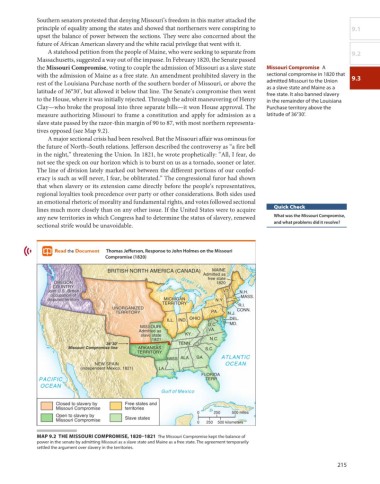Page 248 - American Stories, A History of the United States
P. 248
Southern senators protested that denying Missouri’s freedom in this matter attacked the
principle of equality among the states and showed that northerners were conspiring to 9.1
upset the balance of power between the sections. They were also concerned about the
future of African American slavery and the white racial privilege that went with it.
A statehood petition from the people of Maine, who were seeking to separate from 9.2
Massachusetts, suggested a way out of the impasse. In February 1820, the Senate passed
the Missouri Compromise, voting to couple the admission of Missouri as a slave state Missouri compromise A
with the admission of Maine as a free state. An amendment prohibited slavery in the sectional compromise in 1820 that 9.3
rest of the Louisiana Purchase north of the southern border of Missouri, or above the admitted Missouri to the Union
as a slave state and Maine as a
latitude of 36°30’, but allowed it below that line. The Senate’s compromise then went free state. It also banned slavery
to the House, where it was initially rejected. Through the adroit maneuvering of Henry in the remainder of the Louisiana
Clay—who broke the proposal into three separate bills—it won House approval. The Purchase territory above the
measure authorizing Missouri to frame a constitution and apply for admission as a latitude of 36°30’.
slave state passed by the razor-thin margin of 90 to 87, with most northern representa-
tives opposed (see Map 9.2).
A major sectional crisis had been resolved. But the Missouri affair was ominous for
the future of North–South relations. Jefferson described the controversy as “a fire bell
in the night,” threatening the Union. In 1821, he wrote prophetically: “All, I fear, do
not see the speck on our horizon which is to burst on us as a tornado, sooner or later.
The line of division lately marked out between the different portions of our confed-
eracy is such as will never, I fear, be obliterated.” The congressional furor had shown
that when slavery or its extension came directly before the people’s representatives,
regional loyalties took precedence over party or other considerations. Both sides used
an emotional rhetoric of morality and fundamental rights, and votes followed sectional
lines much more closely than on any other issue. If the United States were to acquire Quick Check
any new territories in which Congress had to determine the status of slavery, renewed What was the Missouri Compromise,
sectional strife would be unavoidable. and what problems did it resolve?
Read the Document Thomas Jefferson, Response to John Holmes on the Missouri
Compromise (1820)
BRITISH NORTH AMERICA (CANADA) MAINE
Admitted as
free state
OREGON 1820
COUNTRY Great Lakes
Joint U.S.-British VT. N.H.
occupation of MASS.
disputed territory MICHIGAN N.Y.
TERRITORY R.I.
UNORGANIZED CONN.
TERRITORY PA. N.J.
OHIO DEL.
ILL. IND.
D.C. MD.
MISSOURI
Admitted as VA.
slave state KY.
1821 N.C.
36°30' TENN.
Missouri Compromise line ARKANSAS S.C.
TERRITORY
MISS. ALA. GA. ATLANTIC
NEW SPAIN OCEAN
(independent Mexico, 1821) LA.
FLORIDA
PACIFIC TERR.
OCEAN
Gulf of Mexico
Closed to slavery by Free states and
Missouri Compromise territories
0 250 500 miles
Open to slavery by
Missouri Compromise Slave states
0 250 500 kilometers
MaP 9.2 thE MiSSoURi coMPRoMiSE, 1820–1821 The Missouri compromise kept the balance of
power in the senate by admitting Missouri as a slave state and Maine as a free state. The agreement temporarily
settled the argument over slavery in the territories.
215

